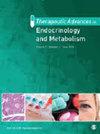心血管磁共振成像透视心外膜脂肪组织在糖尿病心肌病中的作用--叙述性综述
IF 4.6
3区 医学
Q2 ENDOCRINOLOGY & METABOLISM
Therapeutic Advances in Endocrinology and Metabolism
Pub Date : 2024-03-11
DOI:10.1177/20420188241229540
引用次数: 0
摘要
越来越多的证据表明,异位/内脏脂肪可能在与 2 型糖尿病相关的非缺血性心血管疾病的发病机制中起着关键作用。心外膜脂肪组织(EAT)是一种复杂的内脏脂肪库,覆盖心脏表面的 80%,在解剖和功能上与心肌和冠状动脉毗连。脂肪组织通过分泌多种脂肪因子与心肌下层的生物学特性相互作用。磁共振成像(MRI)是心脏结构和功能成像的参考模式。该技术目前也正在成为 EAT 定量的参考成像模式。在这篇叙述性综述中,我们(a)调查了利用心血管核磁共振成像描述 EAT 特征的当代临床研究(2010-2023 年发表的研究);(b)列出了监测 EAT 大小以及心肌功能和结构参数对治疗反应的临床试验;(c)讨论了 EAT 在糖尿病心肌病发展过程中的潜在病理生理作用。我们的结论是,EAT 数量的增加及其炎症表型与左心室功能障碍的早期症状相关,可能在伴有或不伴有冠状动脉疾病的糖尿病患者的心脏疾病发病机制中发挥作用。本文章由计算机程序翻译,如有差异,请以英文原文为准。
Role of epicardial adipose tissue in diabetic cardiomyopathy through the lens of cardiovascular magnetic resonance imaging – a narrative review
Accumulating evidence suggests that ectopic/visceral adiposity may play a key role in the pathogenesis of nonischaemic cardiovascular diseases associated with type 2 diabetes. Epicardial adipose tissue (EAT) is a complex visceral fat depot, covering 80% of the cardiac surface with anatomical and functional contiguity to the myocardium and coronary arteries. EAT interacts with the biology of the underlying myocardium by secreting a wide range of adipokines. Magnetic resonance imaging (MRI) is the reference modality for structural and functional imaging of the heart. The technique is now also emerging as the reference imaging modality for EAT quantification. With this narrative review, we (a) surveyed contemporary clinical studies that utilized cardiovascular MRI to characterize EAT (studies published 2010–2023); (b) listed the clinical trials monitoring the response to treatment in EAT size as well as myocardial functional and structural parameters and (c) discussed the potential pathophysiological role of EAT in the development of diabetic cardiomyopathy. We concluded that increased EAT quantity and its inflammatory phenotype correlate with early signs of left ventricle dysfunction and may have a role in the pathogenesis of cardiac disease in diabetes with and without coronary artery disease.
求助全文
通过发布文献求助,成功后即可免费获取论文全文。
去求助
来源期刊

Therapeutic Advances in Endocrinology and Metabolism
Medicine-Endocrinology, Diabetes and Metabolism
CiteScore
7.70
自引率
2.60%
发文量
42
审稿时长
8 weeks
期刊介绍:
Therapeutic Advances in Endocrinology and Metabolism delivers the highest quality peer-reviewed articles, reviews, and scholarly comment on pioneering efforts and innovative studies across all areas of endocrinology and metabolism.
 求助内容:
求助内容: 应助结果提醒方式:
应助结果提醒方式:


